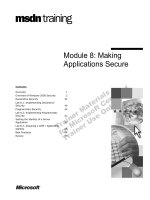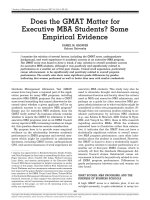Making Out-of-School-Time Matter ppt
Bạn đang xem bản rút gọn của tài liệu. Xem và tải ngay bản đầy đủ của tài liệu tại đây (668.43 KB, 153 trang )
This PDF document was made available
from www.rand.org as a public service of
the RAND Corporation.
6
Jump down to document
Visit RAND at www.rand.org
Explore RAND Education
RAND Labor and Population
View document details
This document and trademark(s) contained herein are protected by law
as indicated in a notice appearing later in this work. This electronic
representation of RAND intellectual property is provided for non-
commercial use only. Permission is required from RAND to reproduce, or
reuse in another form, any of our research documents.
Limited Electronic Distribution Rights
For More Information
CHILD POLICY
CIVIL JUSTICE
EDUCATION
ENERGY AND ENVIRONMENT
HEALTH AND HEALTH CARE
INTERNATIONAL AFFAIRS
NATIONAL SECURITY
POPULATION AND AGING
PUBLIC SAFETY
SCIENCE AND TECHNOLOGY
SUBSTANCE ABUSE
TERRORISM AND
HOMELAND SECURITY
TRANSPORTATION AND
INFRASTRUCTURE
The RAND Corporation is a nonprofit
research organization providing
objective analysis and effective
solutions that address the challenges
facing the public and private sectors
around the world.
EDUCATION and
RAND LABOR AND POPULATION
Purchase this document
Browse Books & Publications
Make a charitable contribution
Support RAND
This product is part of the RAND Corporation monograph series.
RAND monographs present major research findings that address the
challenges facing the public and private sectors. All RAND mono-
graphs undergo rigorous peer review to ensure high standards for
research quality and objectivity.
Making Out-of-School-
Time Matter
Evidence for an Action Agenda
Susan Bodilly, Megan K. Beckett
Prepared for The Wallace Foundation
The RAND Corporation is a nonprofit research organization providing objective analysis
and effective solutions that address the challenges facing the public and private sectors
around the world. RAND’s publications do not necessarily reflect the opinions of its research
clients and sponsors.
R
®
is a registered trademark.
© Copyright 2005 RAND Corporation
All rights reserved. No part of this book may be reproduced in any form by any electronic or
mechanical means (including photocopying, recording, or information storage and retrieval)
without permission in writing from RAND.
Published 2005 by the RAND Corporation
1776 Main Street, P.O. Box 2138, Santa Monica, CA 90407-2138
1200 South Hayes Street, Arlington, VA 22202-5050
201 North Craig Street, Suite 202, Pittsburgh, PA 15213-1516
RAND URL: />To order RAND documents or to obtain additional information, contact
Distribution Services: Telephone: (310) 451-7002;
Fax: (310) 451-6915; Email:
Library of Congress Cataloging-in-Publication Data is available for this publication.
ISBN: 0-8330-3734-X
The research described in this report was conducted by RAND Education and RAND Labor
and Population for The Wallace Foundation.
iii
Preface
e need and desire for a supervised setting and activities for children
and youth during nonschool hours that contribute positively to their
progress toward productive adulthood has grown over the last several
decades. Interest groups, including school-age child-care providers,
youth-development experts, educators, criminal- and juvenile-justice
experts, and poverty experts, have called for increasing public support
for or improving the quality of out-of-school-time (OST) programs.
Some improvement suggestions are modest (requests for expansion of
child-care programming to more needy families); others are more am
-
bitious (that programs can and should aspire to improve academics,
reduce crime, prevent unsafe behaviors, and/or improve social interac
-
tions). Stakeholders in this conversation offer varying pieces of evi
-
dence to support their cases.
Seeking to engage the public in an informed dialogue over the
needs for and the effectiveness of improving or spreading OST pro-
gramming, the Wallace Foundation asked the RAND Corporation to
conduct a broad-ranging literature review to identify, frame, and assess
the relevant issues in the OST field.
is report presents the findings of that review. We identified
and addressed several major issues: the level of demand for OST ser
-
vices, the effectiveness of offerings, what constitutes quality in OST
programs, how to encourage participation, and how to build further
community capacity.
e audience for the report is policymakers, providers, and users
of services interested in improved formal programs for OST and pos
-
sible ways to expand provision.
e research was undertaken by staff in RAND Education and
RAND Labor and Population as part of their mission to provide ob
-
jective policy analysis and effective solutions to address the challenges
facing public and private sectors.
e research sponsor, e Wallace Foundation, seeks to support
and share effective ideas and practices that expand learning and en
-
richment opportunities for all people. Its three current objectives are
to: strengthen education leadership to improve student achievement;
improve out-of-school learning opportunities; and expand participa-
tion in arts and culture. For more information and research on these
and other related topics, please visit its Knowledge Center at www.
wallacefoundation.org.
iv Making Out-of-School-Time Matter: Evidence for an Action Agenda
v
Contents
Preface iii
Figures and Tables
ix
Summary
xi
Acknowledgments
xxi
Abbreviations
xxiii
CHAPTER ONE
Introduction 1
Research Purpose and Questions
3
Methods and Caveats
5
Organization of Report
8
CHAPTER TWO
Historical Context 11
Early Phases of Development
12
rough the 1920s
12
From 1930 to 1950
14
From 1950 to 1970
15
From 1970 to 2000
16
Current Scene
19
Changing Actors and Roles
22
e Debate
27
Implications
30
CHAPTER THREE
Unmet Demand for Out-of-School-Time Services 31
Findings from Surveys or Polls
32
Assumption-Based Estimates of Unmet Demand
34
Program-Level Enrollment Data
35
Program-Level Attendance Data
36
Implications
37
CHAPTER FOUR
Potential Effectiveness OST Programs 41
Nature of the Existing Program-Evaluation Literature
42
Measured Effects
43
Internal Validity, or Whether the Evaluations Measured
and Isolated Program Effects
44
Generalizability and External Validity
45
Findings in the Literature
46
Findings from Existing Syntheses
46
Evidence Concerning School-Age Care
47
Evidence Concerning Academic Achievement and Attainment
48
Evidence Concerning Social Behavior
49
Evidence Concerning Social Interactions
50
Evidence by Grade Level
50
Other Findings and Issues Raised
51
Participation Effects
52
Establishing Reasonable Expectations for Academic Achievement
53
Paying Attention to Program Content and Implementation
to Ensure Positive Impact
54
Program Targeting
55
Needed Cost Information
56
Implications
58
CHAPTER FIVE
Assessment of Quality in OST Programs 61
Literature Sources
62
e School-Age-Care Literature
63
Findings from Statistical Correlations
64
vi Making Out-of-School-Time Matter: Evidence for an Action Agenda
Findings Based on Expert Opinion 65
RAND Synthesis
65
e Youth-Development Literature
66
e Education Literature
69
Effective Schools
70
Class Size
70
Evidence at Training Matters
71
Converging Evidence on Program Factors Associated with
Positive Outcomes
72
Implications
72
CHAPTER SIX
Improving Participation in OST Programs 75
Patterns of Participation in OST Activities
76
Factors Important in Promoting Participation
77
Environmental Factors Associated with Participation
78
Motivation and Intention Factors Associated with Participation
79
Lack of Data on Attitudes about OST Opportunities for
Target Populations
81
Lessons from Practical Efforts to Increase Enrollment
83
Guidance from the Job-Training and Military-Enlistment
Fields on Increasing Enrollment
83
Guidance from the Job-Training and Military-Enlistment
Fields on Increasing Attendance
85
Implications
86
National or Regional Surveys
87
Program-Level Campaigns
88
CHAPTER SEVEN
Capacity Building 89
Nature of the Literature
90
Improving Individual Providers
91
Incentive Systems for Nonprofits
91
Role of Foundations
93
Role of Intermediaries
94
Current Actions
95
Contents vii
Summary 95
Building System Capacity
96
Local Level
96
National-Level Program Development
96
Current Efforts
99
Implications
100
CHAPTER EIGHT
Conclusions 103
Findings and Implications
103
Level of Unmet Demand
103
Effectiveness and Expectations for Outcomes
104
Program Factors Associated with Quality
105
e Means to Improve Participation
106
Capacity Building
107
Summary of the Needed Elements of a Policy Debate
108
Appendix A
111
References
115
viii Making Out-of-School-Time Matter: Evidence for an Action Agenda
ix
Figures and Tables
Figures
2.1. Local Markets with Numerous Providers 14
2.2. Current Scene 21
Tables
2.1. Federal Programs and Roles 23
2.2. National Research and Advocacy Groups 25
4.1. Peer-Reviewed Experimental Design Studies Evaluating
Group-Based OST Programs
47
4.2. Calculating the Cost of Preventive and Youth
Development Programs
57
5.1. Literatures and Sources Used to Identify Program Factors
Associated with Positive Youth Outcomes
63
5.2. Indicators of a Quality After-School Care Program Identified in
RAND Synthesis
66
5.3. Features of Positive Developmental Settings 68
5.4. Program Indicators Supported by at Least Two of the ree
Literatures, by Literature
73
7.1. Literature on Capacity Building 91
xi
Summary
Programs that offer out-of-school (OST) and out-of-home services to
children and youth can be found in every state and locale and run the
gamut from school-age care services supporting working parents, to
programs specifically structured to prevent problematic behaviors such
as drug use or teen pregnancy, to academically oriented programs de
-
signed to improve test scores, to those directed at supporting specific
hobbies and interests.
A loosely connected set of providers, clients, sponsors, and inter-
mediaries make up the local markets referred to as the OST field. is
field and the actors in it have been evolving in response to shifts in the
economy, the growing demand for services associated with increased
numbers of working mothers in the labor force, concerns over youth
development or the lack thereof, and increased academic expectations
for youth.
While public interest in OST programs has waxed and waned in
the United States for more than a century, the past 20 years have been
unprecedented in the growth of provision and the amount of public
financing for these programs. In the past 20 years, interest groups such
as school-age child-care practitioners, youth-development experts, ed
-
ucators, criminal and juvenile justice experts, and poverty experts have
argued that OST programs are part of a solution to problems they see
besetting children and youth. ese groups have successfully drawn at-
tention to OST issues and worked to increase public funding, but they
do not all agree on how to move forward.
Some voices in recent debates over the future of the field say it
is enough for the marketplace to offer school-age care services during
times when parents or relations are not available to supervise children.
Others call for making subsidized programming more widely available.
Still others insist on more ambitious programming to meet a range of
goals, such as improved test scores or reduced crime. Some want OST
providers to be entrusted more than ever before with the academic
skill building of our children, holding specific programs responsible
for improving test scores. Others favor these programs as havens from
the academic pressures of schools, where children can learn social skills
and develop mentors and role models to help them in their difficult
circumstances. Finally, the role of government has grown to support
service provision, and with it has come increasing regulation, account
-
ability, oversight, and concern over meeting more ambitious goals, in
-
cluding improved academic test scores or reduced crime rates.
The Research Purpose
e Wallace Foundation, an active supporter of programs in this field,
asked RAND to provide an objective and systematic examination of the
OST literature to clarify and inform the key issues in the ongoing debates
related to whether and how to improve OST programming. RAND un-
dertook a broad literature review to capture what is known with some
certainty and what is more speculative about claims being made. is
report, the outcome of that review, investigates five major issues:
• the level of unmet demand
• the state of knowledge about the types of outcomes that participa-
tion in OST programs are expected to impact and the nature of
the impacts observed
• determinants of quality in program offerings
• determinants of participation and selection
• practices effective in ensuring that quality programming is avail-
able to meet local demand.
e audience for this report is those active in improving OST
services. is includes service providers, intermediaries, philanthro
-
xii Making Out-of-School-Time Matter: Evidence for an Action Agenda
pists, and policymakers. It can be used as a reference for them on the
above issues, the current state of knowledge about those issues, and the
strength of the evidence base for that knowledge.
We use youth to refer to the period extending from entry into school
through adolescence (approximately ages 6–18). We define the subject of
this examination as the available literature on public, group-based pro
-
grams for school-age children that minimally provide care during non
-
school hours, but might also attempt to improve their behavioral, social,
and academic development outcomes. Many of these types of programs
are offered by community organizations outside the home, such as Boys
and Girls Clubs, YMCAs and YWCAs, parks and recreation depart
-
ments, after-school programs, libraries, and museums.
Findings from the Literature
e review generated the following findings.
Demand for OST Services
A significant debate over the provision of services concerns whether or
not there is pent-up demand for programming. Some advocates claim
significant pent-up demand for OST provision and call on policymak
-
ers to pass legislation providing public funding to ensure universal cov
-
erage. e current trend is to push for capacity expansion, seeking to
offer more slots to meet unmet demand.
More children than ever before are in formal program settings
before and after school, oftentimes providing only child-care services.
Our review, however, found that the limited number of studies docu
-
menting unmet demand for services (1) were based on unfounded as
-
sumptions that cannot be verified; (2) often estimated the total possi
-
ble needs for child-care services, rather than what was demanded from
providers outside the home; and (3) were based on surveys that do not
force the respondent to consider trade-offs in the use of funds, thereby
probably overestimating true demand.
In contrast, studies of existing programs indicate significant num
-
bers of open slots and dropouts, implying unmet demand for existing
Summary xiii
programs is not insistent or pent-up. We did not find systematic evi-
dence of what it is parents and youth are demanding: a safe environ
-
ment, improved or better social behaviors, improved academic out
-
comes, or all of these. We conclude that demand for OST programs,
other than very general current-usage statistics, remains very unclear.
Potential Effects of Programs
We examined evaluations of OST programs to determine what out-
comes they have been able to accomplish. Compared to the total
number of programs operating, very few have been evaluated. e
safety of children in OST provision has not been the focus of many
program evaluations; rather, evaluations have focused on effects on
academic achievement, academic attainment, and social behaviors.
Children who choose to attend OST programs might differ system-
atically from those who choose not to attend in terms of motivation,
aspiration, and other factors. A strong research design would control
for this self-selection bias into the program to isolate its effects from
the effect of the program. Most of the studies reviewed did not con
-
trol for self-selection bias, making it difficult to conclude that differ
-
ences between participants and nonparticipants are wholly attribut
-
able to program effects.
Analysis of the research with the most rigorous designs suggests
that the few programs that have been evaluated have, at best, had mod-
est positive impacts on academic achievement, academic attainment,
and social behaviors such as reduced drug use or pregnancy. Docu
-
mented academic and behavioral program effects sometimes varied by
grade level, background of children, level of participation, program
content by site, and whether the program developed was well targeted
toward the desired outcome. ese evaluations provide few insights
into whether existing programs on average offer a safe and healthy
playtime environment that might satisfy the demands of parents. ere
is no way of knowing if the average program offered would have similar
academic or behavioral effects to those in the programs studied. e
cost-effectiveness of these programs, compared to other interventions,
including expansion of the school day, is not well understood.
xiv Making Out-of-School-Time Matter: Evidence for an Action Agenda
Program Factors Associated with Positive Outcomes
Studies of what features of programs are associated with better out-
comes are often not rigorous and depend on expert opinion. We drew
on recent compendiums or studies of quality indicators in OST or
related settings such as school-age-care literature, youth-development
literature, effective-school literature, analyses of class-size-reduction
programs, and recent studies on teacher-training effects.
ere appears to be a convergence of these multiple, but less rig-
orous, sources on several program factors that might be associated with
improved youth outcomes:
• a clear mission
• high expectations and positive social norms
• a safe and healthy environment
• a supportive emotional climate
• a small total enrollment
• stable, trained personnel
• appropriate content and pedagogy relative to the children’s needs
and the program’s mission, with opportunities to engage
• integrated family and community partners
• frequent assessment.
We note that the field itself has moved toward the development
of standards for service providers with the publication of standards
consistent with the above characteristics. ese factors have not been
formally tested in OST programs or tested for effectiveness in rigor
-
ous experimental studies, but provide a useful cluster of characteristics
upon which to base initial program-improvement efforts. ese im
-
provement efforts should be evaluated to determine whether in fact
they are effective in meeting program outcomes.
Improving Participation
If quality programming is provided, then it might be appropriate to
consider how to improve participation and, especially, how to target
those children and youth who could most benefit from the services.
We drew on a cross-section of fields to understand how to encour-
Summary xv
age and target participation. In recent years, leading behavior theorists
have reached a consensus regarding the most important factors that
determine how people choose to behave, which in turn are influenced
by a host of individual, family, social, and environment factors. Other
fields have made excellent use of these behavioral theories to target or
increase participation.
We found empirical evidence that participation varies by par-
ticipant background, implying that targeting services might increase
participation. For example, lower-income families might be more at
-
tracted to subsidized programs that are located within their neighbor
-
hood and convenient to attend.
Practical ways to increase enrollment and attendance in pro
-
grams have been developed and tested in the job-training and military-
recruiting fields. Proven or promising ways to bolster enrollment rates
in these fields include identifying all possible participants, dedicating
sufficient and effective resources for outreach and recruitment, locating
such efforts in places where targeted youth and their key influencers
congregate, and combining advertising resources across like organiza
-
tions. Monitoring attendance and quality, following up on absentees,
and offering incentives to programs for achieving high attendance rates
are potential ways to improve attendance. Most importantly, to suc-
cessfully target a group and provide accessible services requires knowl
-
edge of their needs at the local level.
Improving Community-Level Provision
While often written about, we found little rigorous empirical evidence
about how to build capacity in the OST field. Studies did provide
notions about how to improve and build capacity both of individual
programs and across local, regional, and national markets. In general,
the review pointed to a few approaches that can be debated, but did
not provide the evidence needed to create a well-crafted agenda.
• Strong arguments were uncovered that point to the effectiveness
of more-integrated approaches with collaboration, joint planning,
and networking as important ways to further the debate, as well as
xvi Making Out-of-School-Time Matter: Evidence for an Action Agenda
identifying shared challenges, best practices, and common inter-
est among the groups involved.
• Historic examples reviewed showed the importance of data collec-
tion and analysis, data-driven decision making, evaluation, self-
assessment, standards, and quality assurance to the development
of other relevant fields.
• More-generic discussions pointed to the need for better incentives
for improved performance, accountability mechanisms, and per
-
haps market-based relationships to engage competition as a way
to increase performance.
Implications
Policymakers and program implementers should remain skeptical of
claims about pent-up demand for programs as well as claims that these
programs can meet multiple needs and impact positively on multiple
outcomes. Rapid growth should make way for concentrating on how
to improve the quality of offerings by existing programs and of systems
of provision.
A public discussion of the goals of OST would benefit from a
better accounting of real demand, both in qualitative terms (what do
children, youth, and parents want in OST programming?) and quan-
titatively (how many slots are demanded for different goals?). e first
steps in that direction are survey-based local-area assessments of de
-
mand, and then matching program content and support to those spe
-
cific needs. Resources would be well spent in assessing local needs and
barriers to participation and developing programs to meet those needs
and remove those barriers. Furthermore, any push toward rapid expan-
sion of slots should be tempered with an assessment of how that expan
-
sion in quantity might affect the quality of the programs offered. e
opposite might also be true: improvement in program quality could
have the effect of increasing demand.
Policymakers should be cautious about overly optimistic predic
-
tions of the effectiveness of OST programming for improving youth
outcomes such as test scores and improved social behaviors. Much de
-
Summary xvii
pends on the specific characteristics of the program and youth who
participate. While programs have been developed that have modest
positive effects on academics and social behaviors, there is no evidence
to support the view that OST programs are a universal panacea for
all the problems that OST proponents claim they are. Based on the
few programs that have been rigorously evaluated and found effective,
it is unrealistic to expect the current generation of OST programs to
achieve most or even some of the outcomes articulated, such as those in
California’s debates on Proposition 49. Designing and implementing
effective programs will take careful planning and attention. It would
also likely take very significant funding.
We summarize here some basic information requirements that
need to be addressed if programming is to be improved and the cur-
rent debate is to become more productive:
• local assessments, using surveys and other field instruments, to
clarify demand for specific services by specific classes of clients
and the level and quality of existing providers
• development of forums for public consideration of the results of
such analyses
• creation of more-systematic program evaluations with proper
controls for self-selection and, where possible, the effect of partic
-
ipation levels; documentation of the impact of varying program
elements or contexts; determination of the effects by age group
or characteristic of participant; and attention to measuring cost
effectiveness
• As there is little value to a strong evaluation of a weak inter-
vention, these quality evaluations should be applied selectively
to large, publicly funded programs and, any well-designed and
funded programs with potentially wide impact (see Walker, 2004,
for ideas on selection)
• dissemination of standardized measures of participation levels and
intensity that are regularly reported and aggregated, combined,
when possible, with serious attention to participation effects in
program evaluations
xviii Making Out-of-School-Time Matter: Evidence for an Action Agenda
• development and dissemination of tools to collect and report cost
information and compiling of information necessary to undertake
cost-effectiveness evaluations, with the ultimate goal of compar
-
ing OST programs to other alternative
• development, demonstration, testing, and evaluation of practical
and cost-effective means to improve participant recruitment and
enrollment practices for targeted services
• development of effective forums and incentives to disseminate ex-
isting standards, guidelines, and best practices as they evolve or
are uncovered through research
• support for collection and analysis of data for use in decision
making about provision of services, stronger monitoring, assess
-
ment, and accountability based on those guidelines and practices,
including stronger incentives for performance.
Summary xix
xxi
Acknowledgments
e authors of this report are indebted to the many people who sup-
ported the work. First and foremost, we thank the management and
staff at the Wallace Foundation for their support throughout this proj
-
ect. Kimberley Jinnett and Ed Pauly were especially helpful in provid
-
ing critical feedback, assisting us in connecting to other very informed
colleagues and practitioners in the field, and providing continued guid
-
ance and assistance.
Several research colleagues in the OST field provided us with crit
-
ical comments at crucial moments, including Karen Pittman, Heather
Weiss, Robert Halpern, and Jean Grossman. We thank them for their
input, without which this report certainly would have suffered. In ad-
dition, we thank the reviewers of the draft for their comments that
helped improve the report: Janet Currie, Robert Granger, and Robin
-
son Hollister.
Finally, we thank our colleagues at RAND for their support in
this project. Sheila Kirby acted as senior adviser to the project and
greatly assisted in creating an effective organization. Others provided
feedback and comments, including Becky Kilburn, Lynn Karoly, and
Arie Kapetyn. In addition, we would like to thank Jennifer Wong and
Heather Barney, who were instrumental in developing the review.
All errors and remaining flaws are the responsibility of the au
-
thors.
xxiii
Abbreviations
AERA American Educational Research Association
BB/BS Big Brothers and Big Sisters
DHHS U.S. Department of Health and Human Services
DoD U.S. Department of Defense
DOEd U.S. Department of Education
DOJ U.S. Department of Justice
ESS Extended-Service School
FY fiscal year
GAO U.S. General Accounting Office
IOM Institute of Medicine
MDRC Manpower Demonstration Research Corporation
MOST Making the Most of Out-of-School Time
NAESP National Association of Elementary School Principals
NHES National Household Education Surveys
NIOST National Institute on Out-of-School Time
NRC National Research Council
NSACA National School-Age Care Alliance
OST out-of-school time
QOP Quantum Opportunities Program
STAR Student/Teacher Achievement Ratio
TASC e After-School Corporation
21st CCLC 21st Century Community Learning Centers
WIA Workforce Investment Act









